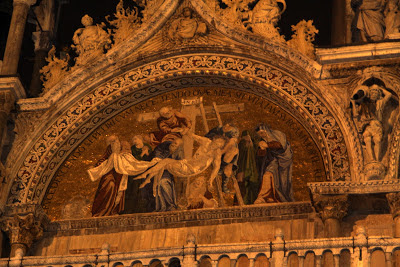Venice
Piazza San Marco:
Piazza San Marco is the principal public square and it is generally known just as "the Piazza". All other urban spaces in the city (except the Piazzetta and the Piazzale Roma) are called "campi" (fields). The Piazzetta (the 'little Piazza') is an extension of the Piazza towards the lagoon in its south east corner. The two spaces together form the social, religious and political center of Venice and are commonly considered together.
San Marco Basilica:
The most famous of the city's churches and one of the best known examples of Byzantine architecture. Originally it was the chapel of the Doge, and has only been the city's cathedral since 1807, when it became the seat of the Patriarch of Venice, archbishop of the Roman Catholic Archdiocese of Venice, formerly at San Pietro di Castello.
For its opulent design, gilded Byzantine mosaics, and its status as a symbol of Venetian wealth and power, from the 11th century on the building has been known by the nickname Chiesa d'Oro (Church of gold).
Bridge of Sighs:
The view from the Bridge of Sighs was the last view of Venice that convicts saw before their imprisonment. The bridge name, given by Lord Byron in the 19th century, comes from the suggestion that prisoners would sigh at their final view of beautiful Venice through the window before being taken down to their cells. In reality, the days of inquisitions and summary executions were over by the time the bridge was built and the cells under the palace roof were occupied mostly by small-time criminals. In addition, little could be seen from inside the Bridge due to the stone grills covering the windows.
A local legend says that lovers will be granted eternal love and bliss if they kiss on a gondola at sunset under the Bridge Of Sighs.
It was designed by Antoni Contino and was built in 1602. It is made of white limestone and has windows with stone bars.
Murano Island:
Murano’s reputation as a center for glassmaking was born when the Venetian Republic, fearing fire and the destruction of the city’s mostly wooden buildings, ordered glassmakers to move their foundries to Murano in 1291. Murano glass is still associated with Venetian glass.
Glass-Blowing Demonstration on Murano Island
Burano:
Known for its small, brightly painted houses, popular with artists. The colors of the houses follow a specific system originating from the golden age of its development; if someone wishes to paint their home, one must send a request to the government, who will respond by making notice of the certain colors permitted for that lot.
Torcello:
Cathedral of Santa Maria Assunta, founded in 639 and with much 11th and 12th century Byzantine work, including mosaics surviving.
Doge's Palace:
A palace built in Venetian Gothic style. Was the residence of the Doge of Venice, the supreme authority of the Republic of Venice.
Rialto Bridge:
One of the four bridges spanning the Grand Canal in Venice, Italy. It is the oldest bridge across the canal. The present stone bridge, a single span designed by Antonio da Ponte, was finally completed in 1591.























Comments
Post a Comment